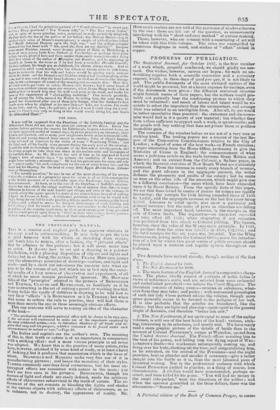THE SKETC HE R'S MANUA, L.
THIS is a concise and explicit guide for amateur students in the royal mad to picture-makin4. It may help to put the tyro in good humour with his efforts at sketching from nature, and teach him to mitnie, after a fashion, the " pictorial effects" that he admires in fine pictures ; but it will never make him an artist. It directs how to set out a drawing in a painter- like fashion, with a pleasing disposition of objects and lights and (links; but in so doing, the author, Mr. FRANK HOWARD, jumps over the elementary principles of thawing—outline, and light and shade—and by a short cut introduces the amateur into what ap- pear to be the arcana of art, but which are in fact only the exter- nal results of a tom!' course of observation and experiment, of all of which he must remain profoundly ignorant. Mr. llowatto talks of the "principles" adopted in the pictures of BONINGTON and TURNER, CLAUDE and REMBRANDT, as familiarly as it' he were instructing in the art of cutting a pencil or washing in a tint. It may tickle the vanity of dabblers in drawing to be told how to vary their "efkcts" h la BONINGTON or A la TURNER; but when they come to reduce the rule to practice, they will find there is more than meets the eye in these seemingly obvious eflixts.
This one sentence will serve to convey an idea of the character of the book-
" The production of common pictorial effect will be shown to be very easy, if the amateur will condescend to make use of the expedients employed by the most celebrated artists,—viz. to introduce shadows ry all hinds and de. frees that may suit his purpose, whether POSSIBLE to be found under such circumstances in nature or NoT."—Page to.
The Italics and capitals are the author's own. The meaning of this is, that truth or nature is of no importance in comparison with a striking effect : and a more vicious principle in art never was adopted. We know this is the practice of many artists, (who Lave, however, attained it by some kind of study, or at least a habit of looking,) but it produces that mannerism which is the bane of talent. STANFIELD and ROBERTS mike very free use of it in manufacturing pictures; and hence the monotony of their styles. TURNER commonly sacrifices local correctness, but his most ex- travagant effects are consistent with nature in the main : you don't see two suns in his pictures. BONINGTON, though his LofEmasses of light and shade are easily defined, made his arbitrary effects of chiaroscuro subservient to the truth of nature. The re- finement of the art consists in blending the lights and shades the various objects with arbitrary effects of chiaroscuro, so as , to enhance, not to destroy, the appearance of reality. Mm'.
Hewett n's readers are not told of the existence of shadows thrown by time some : these are left out of the question, as unnecessarily interfering with his " short and easy method " of picture-making.
Those, however, who are content with a smattering of art will be taken with this little volume. The rules are exemplified by numerous diagrams in wood, and studies of " effect" etched in copper.


























 Previous page
Previous page